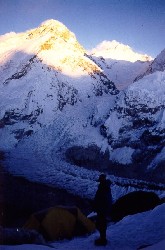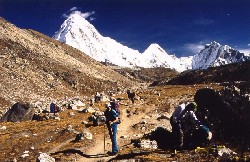‘The Lord Giveth and the Lord Taketh Away’by Mick James |
||
| This was the fourth time that I’d woken in the night, completely out of breath, with pain in the side of my chest and a nasty dry cough. It was as if someone had put a pillow over my head while I was asleep and had somehow managed to manipulate a huge jubilee clip around my rib cage and slowly start tightening it. Outside the storm was blowing harder than ever - I’d already had to pee twice and there was now ice inside my pee bottle. Breathing wasn’t getting any easier and I sat up in an attempt to get more air into my lungs - no better at all - funny, it wasn’t like any of the Chayne Stokes breathing that I’d experienced in South America and it defiantly wasn’t normal even at 20,500ft. I think I’d known what it was for quite a while before I plucked up the courage to unzip the breast pocket of my fleece and take out the diagnostic card : | ||
Pulmonary Oedema (HAPE) :General
: Usually occurs in the first 2 -4 days following ascent to > 2500m,
frequently follows rapid ascent eg 5,000m to 7,000m : 2% incidence
rate.
Treatment :
Secondary :
|
||
What’s Going On : Your heart’s arteries are fracturing and leaking fluid into your lungs, therefore you have difficulty breathing - this puts more pressure on your heart and thus the process is speeded up, effectively internally flooding your lungs. Pressure is the root cause and that is related to altitude - DESCEND. I knew it all anyway - after all I’d written it only three weeks before. As I scanned the card I focused in on symptoms 3 and 4 - sure I’d had no preceding AMS - not even a slight headache, and I’d no idea how my exercise tolerance was, but then again being in the tent wasn’t exactly helping me to test that out. The cold was intense now - it was about 10pm and the roof of the Czech’s Ferrino tent (left behind two weeks earlier when they had all been killed descending from the summit) was covered in frost - as was everything else, our 5 season carrymats were proving ineffectual and the only non cold part was where we’d laid the third carrymat across the pair of us at hip level. Full buffalo suit, complete with hood and a Rab 1100 and I was still uncomfortable - Tich, on the other hand was asleep. Looking again at the card it was time to act - the little bottle of pills that we all carried was in my breast pocket - pull out the nifedepene and start the treatment - we only carried 24hrs of pills - any longer and we figured it wasn’t worth it. Hearing the rattle of pills brought Tich out of his slumber - never the prettiest as he wakes up Tich was now scanning me dubiously, sitting there wheezing and coughing and panting like a dog that’s run uphill in the sun all day. The words were not really necessary “I’ve Pulmonary”, “OK” - what else is there to say, at least now he might know why if he wakes up next to a stiff. |
||
I’ve never really thought much about death in the past, but I knew the chances of this one and I knew that being pinned in the tent by the storm was in not exactly aiding my chances of life - stay alive and hope it blows through in the morning. I felt strangely calm - matter of fact almost - for saying that I could barely breath, and that I was freezing my nuts off. I wasn’t keen on sleep from that point on. For hours on end I thought about living, not about anything specific, the great times I’d had, the parties, the routes, the people in my life - just living, in an abstract kind of a way, and by morning I was still alive. The storm was gone and the landscape changed as the foot and a half of fresh snow twinkled in the bright morning light. Tich was dressing me for action, helping with my boots and crampons, Kami - our sherpa was helping with may harness and then off we go down the absail ropes. It’s too cold for them to lower me and it’d take too long, but my motivation to descend transcends the pain and we’re away, not exactly flying, but moving well, struggling whenever the ground isn’t sloping down, and suddenly I’m at the small rise before Advanced Base Camp. 20 minutes to move up the 20 meter rise in the slope, but I’ve so much adrenaline that we walk away and, unbelievably, leave the oxygen at ABC. Thirty minutes later, I’m regretting it and Tich is worried. My throat is so dry from the coughing and hyper ventilating that it feels like someone’s shoved a piece of cardboard in my mouth and I can now no longer step over the many boulders that make up the moraine descent to our base camp. The next stages of HAPE start to appear and now its blood coming up as I cough - not much, but hey I’d rather my lungs stayed inside if you know what I mean. Back at base camp after a scary descent and I’m in the mess tent - the boys have my chest expanded and I’m worse than ever - hyperventilating and crying ‘cos I think I’m going to black out and if that happens then I know I’m never coming round. Half an hour of this is more than enough and they get me ready to go further down - the Sirdar has been and got oxygen from the Slovinians and I’m strapped up to the mask and breathing almost normally for the first time in over 12 hours. For another 8 hours I descended - always slowly, turning my back to Everest and knowing that I’d be lucky to ever even see it again. I was using my ski sticks for assistance - there’s not much that anyone can do to help as the huge blocky moraine is so broken - the guys came with me carrying the oxygen and ready to help me out with encouragement food and liquids. Just before dark we made it into Pheriche and I slumped into the Himalayan Rescue Association Clinic. |
||
It was the first time in nearly 24 hours that I had been able to breath normally whilst at rest, although walking anywhere left me breathless. The diagnosis was a formality - crackly lungs the works. That night it snowed again - for over 24 hours the snow fell - our position on the mountain would have been desperate, had we stayed, with little chance of retreat. The guys drifted back to base camp and after 4 days of rest I felt well enough to descend a bit and then move on up again towards Gokyo. The doctors had told me that I may be able to ascend again to base camp at 5,200m and instead of a return to the scene of the crime I thought I’d explore a bit. Taking it easy I reached Gokyo and after reaching Gokyo Peak I promptly became ill again. This time I was in no doubt and headed for home - a painful few days saw me back in Namche - this time things did not improve and by the time I reached Lukla I was still unable to walk uphill without panting - so much for 5 weeks of acclimatisation, and so much for my mates who were all super human at this altitude. Back in the UK I could not even make it up Arthur’s Seat on my first weekend back. The doctors checked me out - no long term damage - I’ve seen my heart on the scanners and have been tested with air mixes to induce a recurrence - information is vague and my future high altitude career is over - “I think you’d be fine in the Alps as they can chopper you off in 5 mins” was not what I was really hoping for, but then I am still alive. Six months after my incident and I feel fine - I’ve run in the Lowe Mountain marathon, and I’ve managed to climb The Chasm - I’m pleased to be back in Scotland and I’m fortunate enough to still be able to enjoy the outdoors in the way that I always have. |
||


